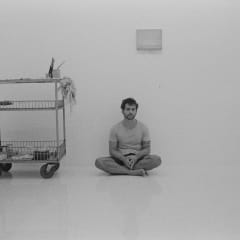Lucas Arruda at Daitoku-ji Lucas Arruda
Daitoku-ji Ōbai-in Temple, 大徳寺黃梅院
80 Daitoku-ji Murasakino Kita-ku, Kyoto, Japan
Located in the Kita ward of Kyoto, Daitoku-ji (大徳寺) is a Zen Buddhist temple, significant for its reverence and projection by warlords in the Sengoku-period. Consisting of nearly two dozen smaller temples, it is the seat for the Rinzai sect of Japanese Zen Buddhism.
The temple was established in 1315 by Zen master Shūhō Myōchō. It flourished during the Muromachi period with the support of Ashikaga Yoshimitsu, the shogun who also built Kinkaku-ji (sometimes known as ‘the Golden Pavilion’). Daitoku-ji played a significant role in historical tea culture through its association with famous tea masters such as Sen no Rikyū (1522-1591), renowned during the Sengoku period, who developed the notion of the tea ceremony, intertwining his tea aesthetics with the Zen spirit of the temple.
Lucas Arruda focuses on the landscape genre, using an approach that explores complex mental states and our experience of light and perception rather than specific locations – obstinately thinking and experimenting with our capacity of living through the mediation of light and the gaze. Arruda’s scenery exists at the point of tension between abstraction and figuration, between apparition and emptiness. With each gaze, experiences are delineated through a process of constructing and reconstructing memories, as if the arrangement of color fields has interacted with intangible landscapes and felt sensations. As viewers move above and below horizon lines, atmospheres laden with visual and metaphysical questions unfold. Between sky and earth, the ethereal and solid, imagination and reality, meditative contemplation finds its routine while following an endless cycle of sublimation and deposition of matter.


